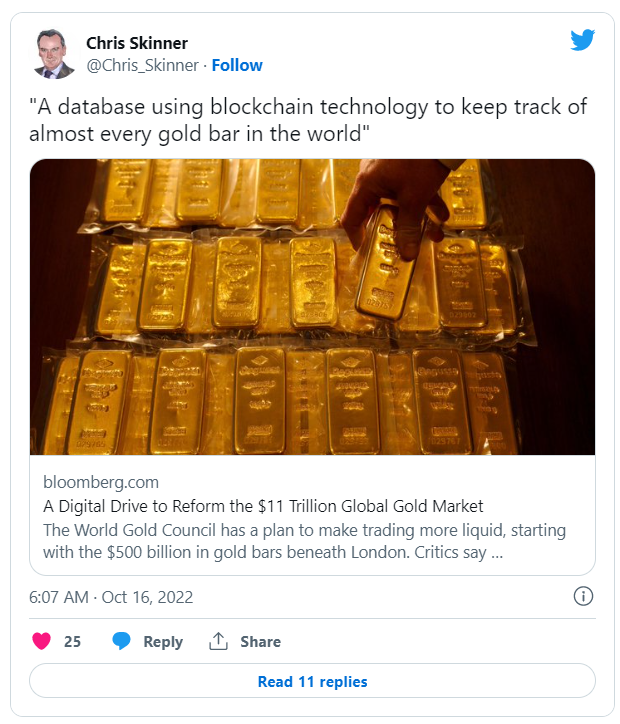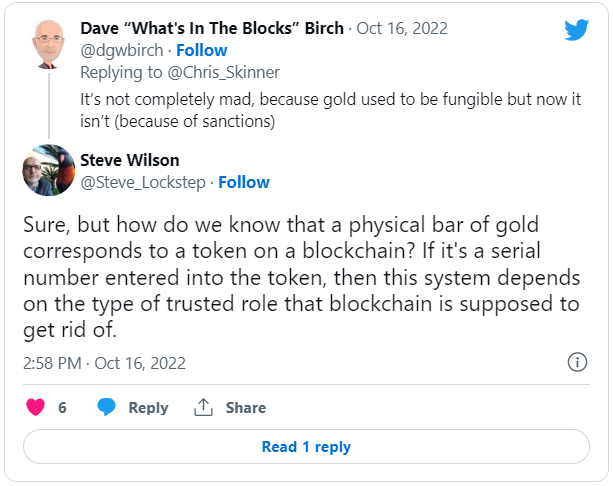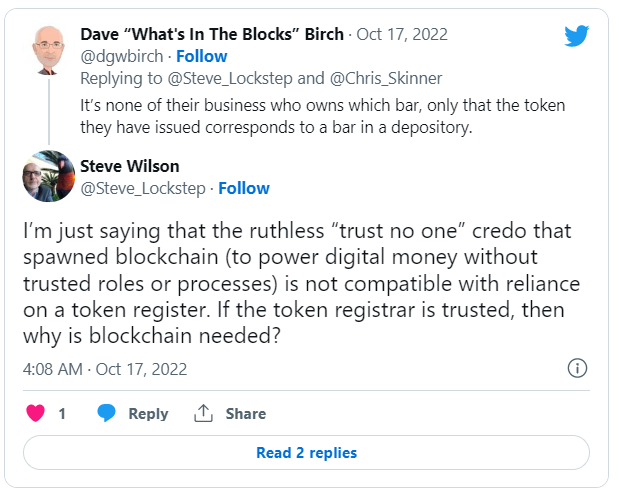During the week I tweeted an interesting quote from a start-up firm

The story is based upon a reimagining of the gold trade. As Bloomberg explains:
Trading on one of the world’s oldest markets depends on a network of high-security vaults located underneath Greater London. There, some 50,000 gold bars, each worth more than $650,000, change hands every day among the four big banks in charge of processing transactions.
The system, which includes some $500 billion worth of gold stored in locations, has been trundling along with little change for most of the past two decades. David Tait, who heads the World Gold Council, the main lobby group for miners of the metal, thinks it’s time for an overhaul.
The former investment banker is trying to push through changes he hopes will significantly increase demand, including a database using blockchain technology to keep track of almost every gold bar in the world. Once that’s up and running, he says, it should be possible to create a digital token backed by physical gold that can be more easily traded.
The idea is that the World Gold Council will run gold trading 24 hours a day securely or, as the company puts it, Gold247.
Gold247 transformation is focused on three pillars of work: integrity, accessibility and fungibility. These three pillars are underpinned by the digitalisation of gold and the digital transformation of the gold market’s infrastructure. This initiative aims to enhance trust in gold, and as a consequence, unlock substantial demand.
Will this work, one may ask? Well, the idea was spawned by banking reforms post-2008’s financial crash, except that the latest implementation this year makes trading gold even more expensive with reduced margins.
Post-financial crisis banking reforms began to affect gold this year after market participants were unable to prove that the asset could easily be traded in stressful times. The new rules, in effect, made it more expensive for banks to hold bullion, compressing the already meagre returns they make trading the commodity, and raising concerns the market will shrink. And in the past decade, gold has faced growing competition from cryptocurrencies.
So, what’s blockchain got to do with it?
The World Gold Council claim it’s all about integrity, transparency, trust and provenance. They call it the Gold Integrity Program. Each physical gold bar will be recorded on the blockchain with a digital twin. This will create fungible, interoperable markets, and ensure trust in trading gold.
The World Gold Council has partnered with the London Bullion Market Association (LBMA) to do this. LBMA manages the trading is conducted amongst its members, loosely overseen by the Bank of England. Most of the members are major international banks or bullion dealers and refiners.
The interesting thing is that from my first tweet, it created quite a big debate, as demonstrated by Dave Birch’s intervention.

It’s worth following and checking out all the threads and links in my first tweet to see the full debate.

Nevertheless, the core issue is going to be getting agreements worldwide that this could work, which is the core of these debates.
The token Tait’s team envisions would need the backing of the entire market, from Wall Street banks to the Indian and Chinese authorities who run the top consumer markets.
This runs back to the core of why most blockchain use cases fail. It’s not about applying blockchain. It’s about getting industry agreements across multiple players worldwide and driving standardisation and interoperability. So funny, as that’s been the debate at most Sibos conferences since the dawn of time.
Good luck with this Mr. Tait as, after all, if you achieve the vision it would be truly digital gold!
Related: The FinTech Bloodbath



